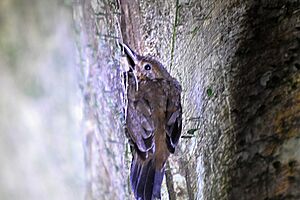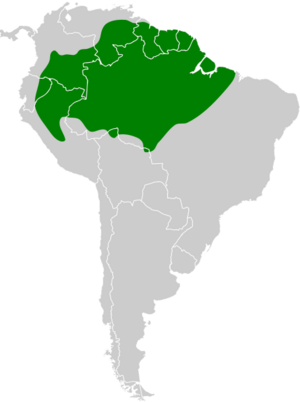Short-billed leaftosser facts for kids
Quick facts for kids Short-billed leaftosser |
|
|---|---|
 |
|
| Conservation status | |
| Scientific classification | |
| Genus: |
Sclerurus
|
| Species: |
rufigularis
|
 |
|
The short-billed leaftosser (Sclerurus rufigularis) is a cool bird that lives in the forests of South America. It's part of the ovenbird family called Furnariidae. You can find this bird in many countries, including Bolivia, Brazil, Colombia, Ecuador, French Guiana, Guyana, Peru, Suriname, and Venezuela.
Contents
About the Short-billed Leaftosser
The short-billed leaftosser is a strong, stocky bird with a short tail. As its name suggests, it has the shortest bill of all the leaftosser birds. It grows to be about 15 to 16 centimeters (6 inches) long and weighs between 19 to 25 grams (less than an ounce!). Both male and female leaftossers look very similar.
The main type of short-billed leaftosser, called S. r. rufigularis, has a dark brown face. Its head is dark brown with a hint of red. Its back is reddish-brown, and its tail feathers are a darker chestnut-brown. Its wings are dark reddish-brown, and its tail is a sooty black.
Its throat and cheeks are a dull orange-red color. This color gets richer on its upper chest, which also has thin, pale stripes. The rest of its belly is a rich reddish-brown. Its eyes are dark gray-brown, and its beak is black and gray. Its legs and feet are black, brownish, or gray. Young leaftossers look much like the adults, but their rump (the area above their tail) is a bit duller.
Other types of short-billed leaftossers have slightly different colors:
- S. r. fulvigularis is more olive-brown than reddish-brown. Its throat is lighter, and its upper chest has wider reddish stripes.
- S. r. brunnescens is darker and less reddish than fulvigularis.
- S. r. furfurosus is generally paler than the main type.
Where They Live and What They Like
The short-billed leaftosser lives in tropical lowland evergreen forests. These are forests where trees stay green all year round. They prefer "terra firme" forests, which means the ground is firm and not flooded.
You can find different types of short-billed leaftossers in specific areas:
- S. r. fulvigularis lives in southern Venezuela, across the Guianas, and into northern Brazil.
- S. r. furfurosus is found in northern Brazil, north of the Amazon River.
- S. r. brunnescens lives in southeastern Colombia, eastern Ecuador, northeastern Peru, and northwestern Brazil, all north of the Amazon.
- S. r. rufigularis is found in northeastern Peru, eastern Bolivia, and southwestern and south-central Brazil, all south of the Amazon.
These birds usually live from near sea level up to about 500 meters (1,600 feet) high in Brazil. In Ecuador, they are rare above 300 meters (1,000 feet). In Colombia, they can be found as high as 1,800 meters (5,900 feet), but they usually stay lower.
How They Behave
Daily Life
The short-billed leaftosser stays in the same area all year long; it doesn't migrate.
What They Eat
These birds spend most of their time looking for food on the ground. They hop around, flipping aside leaves and picking up insects and other small creatures from the ground and leaf litter. Their diet includes spiders, insect eggs, ants, beetle larvae, adult beetles, and winged termites.
Reproduction
Not much is known about how the short-billed leaftosser raises its young. Scientists believe they probably nest in a burrow, just like other birds in their group.
Their Song and Calls
The short-billed leaftosser's song is a fast series of high-pitched notes. The notes start high, go down, then up and faster, and finally become level and slower. Their calls have been described as "suip" or a very high "siew siew".
Their Status in the Wild
The IUCN (International Union for Conservation of Nature) has listed the short-billed leaftosser as a species of Least Concern. This means they are not currently in danger of disappearing. They live in a very large area, but their exact population size isn't known, and it's thought to be decreasing.
There are no immediate threats that scientists have found for this bird. While they are generally uncommon in most places, they are fairly common in Venezuela. They also live in many protected areas. However, they don't like forests that have been cut down or broken into smaller pieces.


